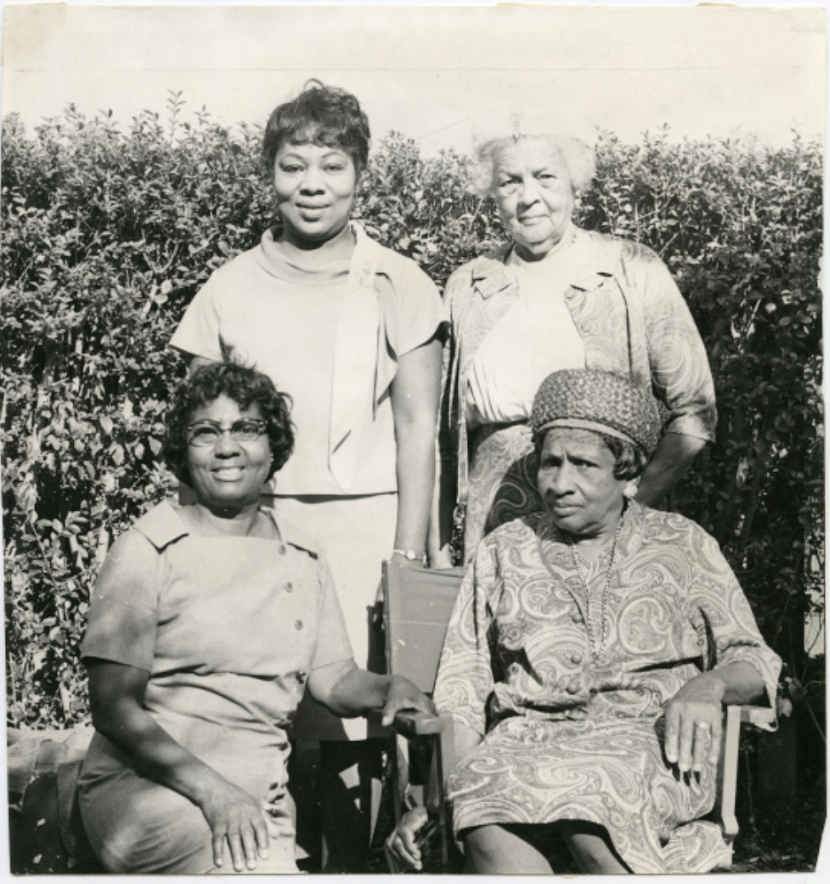Celebrating Oakland's Black Garden Clubs
BY UGO IKORO
Black Food, Love & Liberation is an ongoing series curated by our Digital Culture Fellow, Ugoada Ikoro. Each week, Ugo captures stories of joy, beauty, community care, and thriving (beyond surviving) hidden beneath mainstream narratives shaping Black foodways and our relationships to the land. This month’s theme? Unearthing Liberatory Black Foodways in Oakland, CA.
“Members of the Carver Garden Club,” Courtesy African American Museum & Library at Oakland Photograph Collection, 1960.
“This is African American life—this is a creativity and an artistry of African American life, especially under the harshest conditions.”
—Wambui Ippolito
Perusing through the historical legacies of our plant and garden journey, spurred on by the brilliant spirits of my people—who cultivated spaces that they were told should remain desolate, unkempt, and sultry—I am reminded that I too am a creator that came to this world to make beautiful things.
That’s it. Maybe this year, I’ll plant daffodils by the end beds, or map out perennials and produce that would make the neighbors smile as they pass along the sidewalk.
“Mayme Netherland gardening in front yard,” Courtesy African American Museum & Library at Oakland Photograph Collection, c 1920s
Many of the green spaces we see today across Oakland—from community gardens to small acreage farms—sprouted from networks of Garden Clubs organized nationwide in the 20th century to nourish the budding ecosystems of people, places, and plant life. Black neighbors gathered together, with hoe and trowel in hand, to craft beds as their ancestors had done—sowing seeds of sovereignty and collective care into present and future generations of residents.
Group photograph in Ruth Lasartemay's (top left-right) garden, founder of the East Bay Negro Historical Society, alongside Mamie Fortune, Edna B, Willis (seated, left-right), and Iantha Villa (seated, right-left), President of the Oakland Outdoor Garden Club. Courtesy African American Museum & Library at Oakland Photograph Collection, 1969
“Black garden clubs across the United States were instrumental in registering citizens to vote, undertaking neighborhood and community betterment, championing food access, and fostering civic engagement on many levels.”
—Hadley Keller, The Lasting Legacy of Black Garden Clubs in America
Garden clubs, such as the Negro Garden Club of Virginia, the served as healing spaces to not only connect our past to the present, but as spaces that encouraged social activism, healing, and belonging long before national movements brought those same issues into broader visibility.
By the mid-20th century, the Carver Garden Club and many others that sprouted up in the East Bay were educating the community on flower and garden cultivation practices that celebrated and honored cultural traditions. Embedded in those nourishing gardenscapes was the ancestral wisdom that we are not just beautiful creations ourselves, but creators of beauty as well.
East Bay lot transforming into foodshed for community nourishment, restoration, and renewal, Courtesy East Bay Negro Historical Society Records, 1988
As people of African descent, we’ve shifted the entire landscape of this country from the topsoil up. Our celebration and reverence of the land are ways to explore liberatory means of getting back to our roots. Through our abundant beginnings, sown long before we arrived at the discourse of scarcity prevailing in the food justice movement today, we are reminded that cultivating spaces of beauty, from the fields to one’s home to one’s community through the power of plants, people, and care for the land is revolutionary.
“Cultivating spaces of beauty, from the fields to one’s home to one’s community through the power of plants, people, and care for the land is revolutionary.”
Photo of my raised bed garden in West Oakland, Spring 2023
About the author
Ugo is a storyteller, food & public health justice advocate, and land steward. During the 6-month Digital Culture Fellowship, she'll be exploring her foodways and how systems of oppression have shaped the ways Black people engage with food culture in the US and across the Diaspora. Through tending to the land, discovering the practices of her ancestral lineage, and finding inspiration in the stories and legacies of Black land predecessors and successors, Ugo is bridging gaps in how we tell stories about our connections to the Earth and each other.
Want to keep up with this series? Be sure to subscribe to our newsletter to get Ugo’s explorations straight to your inbox!
Digging Deeper
Interested in connecting with the historic and present-day green roads (community gardens, farming collectives, etc.) that make Oakland’s foodways so powerful and deeply nourishing? More on that below:
Much love and appreciation to the African American Museum & Library at Oakland, which offers an expansive Gardening Collection ripe with archives of collected digitized photographs, oral histories, and books on the history of gardening and farming in the East Bay and beyond.
Tune into this 1972 interview with Iantha H. Villa, President of the Oakland Outdoor Club, founded in 1969, discussing the club’s involvement and day-to-day engagements.
“When Their Community Needed It Most, They Opened A Place To Connect With Nature” Connect with Blk Girls Green House, a Black women-owned plant and apothecary sanctuary in West Oakland, in their piece with Essence on honoring the past by reconnecting the community to greenery, and the celebration and joys of plant care.
Be inspired by the work happening at Black Sanctuary Garden—a multi-visionary garden installation that nourishes our connection to peace, self-care, and healing to Oakland, CA, and the African Diaspora at large.
Let’s get together in connecting Oakland and East Bay residents to the beautiful garden spaces present across the community! Consider supporting the cultivation of a running list of Black-owned garden and farm spaces here.🌱







